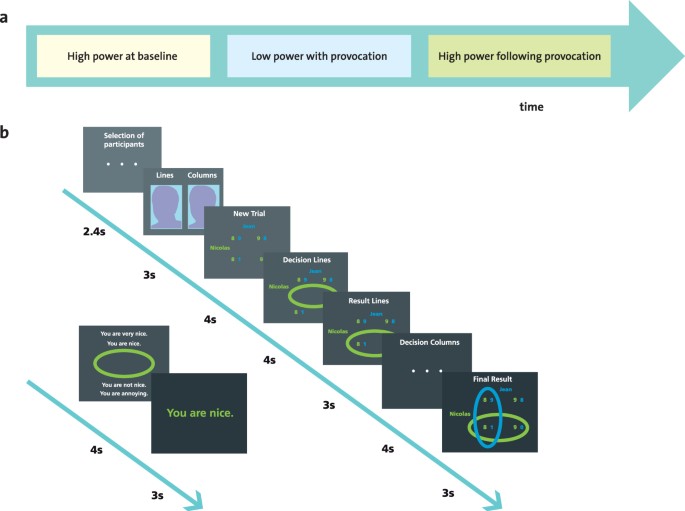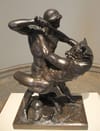One major issue I have with moral philosophy is, due to the kinds of people that gravitate to it, most everyone in the field seems to inevitably conclude:
Utilitarianism good, everything else deontological, socially-constructed, and primitive
This monoculture leads to continually rehashing tired synthetic allegories like the trolley problem (whose agentic solution is to derail the trolley before shooting the philosopher who tied the victims to the track, which is never a normative solution offered). Or Joshua Greene's equally-reductive dual-process theory. Jonathan Haidt's field work with humans outside of the Northeastern US led him to a more nuanced moral foundations theory, but none of this tells us as much about morality as art, and now, neuroscience.
Revenge and Justice
Moving on to the point of this post, it's about a Nature study published in 2018 that sought to examine revenge and punishment of the wicked.

A game was played called the Inequality Game, in which some players were fair and others were unfair. The test subjects came to be angry at the unfair players, reflected in the activation of the right amygdala, Cernunnos. What the researchers were probing was how the test subjects would act when they were in a position of power over the unfair player, to make economic choices on their behalf. This created the dilemma of punishing the unfair player by tanking the choice vs. fairly making beneficial choices as the bigger person.
Right IFSa, Theseus

Cortical region IFSa is a very interesting parcel of cortex. First of all, this region seems to be the main prefrontal projection nexus of the cerebellum, via the thalamus. The role of the cerebellum in cognition has only recently become appreciated, and has been characterized as a "smoothing" or "mellowing" influence, analogous to its role in smoothing motor movements. So we have to think of the IFSa as partly reflecting the input of the subtle cerebellum.
Right IFSa has previously shown up in experiments involving third-party punishment (3PP). 3PP refers to people (or animals) that observe a perpetrator harming a victim other than oneself, and deciding to deal oneself in to administer punishment of the perpetrator despite having no personal stake in the matter. For example, right IFSa has shown up in fMRI studies of juries deciding guilt and sentencing severity.
We chose the Greek mythological hero Theseus to represent right IFSa because his story arc frequently involves punishing injustice, at great personal cost, just for the sake of correcting karmic imbalances. His Six Labours each involved challenging an Underworld figure and slaying them by their own cruel methods. For example, he took on Procrustes, who tied travelers to his bed and cut off their legs to fit, and dispatched Procrustes in the same gruesome way. He slew bandits everywhere, just because that's who he was. He famously traveled to Crete to slay the Minotaur and rescue the maidens trapped in the labyrinth. He tried to rescue Persephone from Hades, but wound up trapped there until Heracles later came and freed him.
Right IFSa in Punishment Restraint

While right IFSa (Theseus) is usually involved in deciding to administer 3PP, in the present study it showed up in restraining punishment of the unfair player. This is an interesting reversal, perhaps calling to mind when Theseus pursued Pirithous for stealing his cattle, but wound up forgiving his transgression and even becoming close friends. For Theseus was always proportional in his justice administration.
Choosing the Just Action

When making economic choices on behalf of the unjust players, an additional cast of characters was recruited to aid right IFSa (Theseus):
- Right PGi: Michael (the archangel), who shows up frequently in moral decisions. He discerns between forgivable and unforgivable transgressions.
- Right 8AV: Cassandra, the Greek woman who was cursed with a gift of prophecy that would always go unheeded. Right 8AV is differentially active in political conservatives, and one of its key roles seems to be to calculate the distant consequences of choices. We might think of right 8AV here thinking about the long-term consequences of punishing the unfair person vs. being the bigger person and representing them authentically.
- Right 8C: Ganesha, Hindu remover of obstacles. Right 8C is recruited when there is an obstacle to proceeding forward with action, and may be regarded as an inventive "troubleshooting" brain region. Its left-side homologue left 8C is named Prometheus, representing figuring out how something can be accomplished, while the right side is recruited when a particularly nasty obstacle is encountered. We may view the two regions as synergistic. In this study, we may view right 8C as removing the obstacles to either punishing or making earnestly beneficial decisions on behalf of the unfair players.
- Left 7m: Thespis, the first Greek actor. 7m notably shows up in actors when playing a part, but also more generally when attempting to imitate or represent another's point of view. This brain region frequently shows up in moral reasoning, perhaps to represent an agent in hypothetical situations.
- Left d23ab: Grimm, the compiler of cautionary tales. Area d23ab seems to be a storehouse of experience-based heuristics, such such as a heuristic Napoleon might offer: "never invade Russia in winter". This region has been found to be reset in after psilocybin treatment, perhaps releasing the blockers that our pasts have set for us. We may speculate that its activation here might guide us on whether to punish the unfair person based on experience in similar situations.
The neuromythographic archetypes provide satisfying context for the Nature study, consistent with past experiments.




